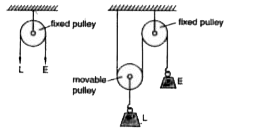If a pulley is weightless and frictionless, is its mechanical advantage
(i) greater than
(ii) equal to
(iii) less than its velocity ratio.
To determine the relationship between the mechanical advantage (MA) and the velocity ratio (VR) of a weightless and frictionless pulley, we can follow these steps:
1. Understand the Definitions:
- Mechanical Advantage (MA): It is defined as the ratio of load (output force) to effort (input force). Mathematically, MA = Load / Effort.
- Velocity Ratio (VR): It is defined as the ratio of the distance moved by the effort to the distance moved by the load. For a simple pulley, VR = Distance moved by effort / Distance moved by load.
2. Consider a Weightless and Frictionless Pulley:
- In a weightless and frictionless pulley, the tension in the rope is the same on both sides of the pulley. Therefore, the force exerted (effort) is equal to the force experienced by the load.
3. Calculate Mechanical Advantage:
- Since the tension is the same on both sides, we can say that:
- Load = Tension
- Effort = Tension
- Therefore, MA = Load / Effort = Tension / Tension = 1.
4. Calculate Velocity Ratio:
- For a simple pulley, the distance moved by the effort is equal to the distance moved by the load. Hence, VR = Distance moved by effort / Distance moved by load = 1.
5. Compare MA and VR:
- From the calculations, we find that:
- MA = 1
- VR = 1
- Therefore, MA is equal to VR.
6. Conclusion:
- The mechanical advantage of a weightless and frictionless pulley is equal to its velocity ratio.
Final Answer:
The mechanical advantage is (ii) equal to its velocity ratio.
---
- Mechanical Advantage (MA): It is defined as the ratio of load (output force) to effort (input force). Mathematically, MA = Load / Effort.
- Velocity Ratio (VR): It is defined as the ratio of the distance moved by the effort to the distance moved by the load. For a simple pulley, VR = Distance moved by effort / Distance moved by load.
- In a weightless and frictionless pulley, the tension in the rope is the same on both sides of the pulley. Therefore, the force exerted (effort) is equal to the force experienced by the load.
- Since the tension is the same on both sides, we can say that:
- Load = Tension
- Effort = Tension
- Therefore, MA = Load / Effort = Tension / Tension = 1.
- For a simple pulley, the distance moved by the effort is equal to the distance moved by the load. Hence, VR = Distance moved by effort / Distance moved by load = 1.
- From the calculations, we find that:
- MA = 1
- VR = 1
- Therefore, MA is equal to VR.
- The mechanical advantage of a weightless and frictionless pulley is equal to its velocity ratio.
The mechanical advantage is (ii) equal to its velocity ratio.
Similar Questions
Knowledge Check
The lever for which mechanical advantage is less than one has
Athe fulcrum between the load and the effortBload between the effort and the fulcrumCeffort between the fulcrum and the loadDload and the effort acting at the same pointIts value can be greater than one:
AMPCBMPSCAPSDAPC
When does the terminal voltage of a cell become (i) greater than its emf (ii) less than its emf ?
View SolutionFor _____ order lever, mechanical advantage (MA) is always greater than 1.
View SolutionFor _____ order lever, mechanical advantage (MA) is always greater than 1.
View SolutionAn angle is greater than 45∘. Is its complementary angle greater than 45∘ or equal to 45∘ or less than 45∘?
View SolutionPulley is the most commonly used simple machine to draw water from a well since
(A) its mechanical advantage is greater than one
(B) it changes the direction of application of effort and makes it convenient to draw water
View SolutionIf the mechanical advantage of a machine is 6 and the velocity ratio is 8, what is its efficiency?
View Solution

